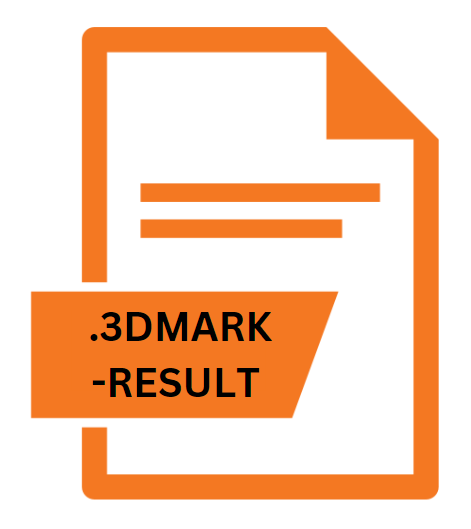.3DMARK-RESULT File Extension

3DMark Results File
| Developer | FutureMark |
| Popularity | |
| Category | Data Files |
| Format | .3DMARK-RESULT |
| Cross Platform | Update Soon |
What is an 3DMARK-RESULT file?
The .3DMARK-RESULT file extension is primarily associated with Futuremark’s 3DMark, a widely used benchmarking tool renowned for evaluating the graphical prowess of computer systems.
These files store comprehensive test results, including but not limited to frame rates, graphical fidelity, and system performance metrics across various tests and benchmarks conducted within 3DMark.
More Information.
The inception of .3DMARK-RESULT files can be traced back to the early iterations of 3DMark. As computer hardware advanced and the need for standardized performance evaluation became more apparent, Futuremark devised a system to log and store the results of benchmarking tests.
These files were initially aimed at providing enthusiasts, overclockers, and hardware reviewers with detailed insights into the capabilities of their systems, allowing them to fine-tune hardware configurations for optimal performance.
Origin Of This File.
Futuremark Corporation, now a subsidiary of UL (Underwriters Laboratories), introduced 3DMark in the late 1990s.
Initially conceived as a graphical performance benchmark for PCs, 3DMark has evolved over the years to encompass various tests for assessing the capabilities of not only desktop computers but also laptops, tablets, and smartphones.
As a natural extension of its benchmarking capabilities, .3DMARK-RESULT files came into existence to provide users with detailed reports of their system’s performance.
File Structure Technical Specification.
.3DMARK-RESULT files are typically structured in a proprietary format designed by Futuremark. While the exact specifications of this format may not be publicly available due to proprietary concerns, it’s understood that these files contain a wealth of information regarding the hardware and software environment in which the benchmarking tests were conducted.
This includes details such as CPU and GPU specifications, operating system versions, driver versions, and specific test results.
The structure of .3DMARK-RESULT files is organized hierarchically, with sections dedicated to different aspects of the benchmarking process.
These sections often include metadata describing the test environment, raw performance data collected during the tests, and computed scores based on the test results.
How to Convert the File?
Given the proprietary nature of .3DMARK-RESULT files, direct conversion to other formats may not be feasible without specialized tools or software provided by Futuremark.
Users can often export or save the results from 3DMark in more accessible formats such as CSV (Comma-Separated Values) or TXT (Plain Text). These formats offer greater flexibility for further analysis or manipulation using a variety of software tools.
To convert .3DMARK-RESULT files to CSV or TXT:
- Open 3DMark: Launch the 3DMark application on your system.
- Load Results: Load the .3DMARK-RESULT file containing the results you wish to convert.
- Export Data: Look for an option within 3DMark to export or save the results in CSV or TXT format. This option is typically found within the application’s menu or settings.
- Choose Output Format: Select the desired output format (CSV or TXT) and specify any additional preferences or options for the conversion process.
- Save File: Once configured, initiate the conversion process and save the converted file to your desired location on your system.
Advantages And Disadvantages.
Advantages:
- Comprehensive Performance Evaluation: .3DMARK-RESULT files provide detailed insights into the performance capabilities of a computer system, allowing users to identify strengths and weaknesses accurately.
- Standardized Reporting: Futuremark’s 3DMark is widely recognized as a standard benchmarking tool in the industry, lending credibility to the results stored in .3DMARK-RESULT files.
- Comparative Analysis: Users can compare their system’s performance against a vast database of results from other users, providing valuable context and benchmarks for improvement.
Disadvantages:
- Proprietary Format: The proprietary nature of .3DMARK-RESULT files can limit interoperability with third-party software or tools, restricting how users can analyze or manipulate the data.
- Limited Utility Outside of Benchmarking: While invaluable for benchmarking purposes, .3DMARK-RESULT files may have limited utility in other contexts, as they are tailored specifically for storing benchmarking data.
- Potential for Misinterpretation: Without a thorough understanding of the benchmarking process and the nuances of the data stored in .3DMARK-RESULT files, users may misinterpret or misrepresent the results, leading to erroneous conclusions.
How to Open 3DMARK-RESULT?
Open In Windows
- Launch 3DMark: Open the 3DMark application installed on your Windows system.
- Load Results: Navigate to the “Benchmark” or “Results” section within 3DMark and locate the option to load existing results.
- Select File: Choose the .3DMARK-RESULT file you wish to open from your file system.
- View Results: Once loaded, the results should be displayed within the 3DMark application, allowing you to analyze and explore the performance metrics captured during the benchmarking tests.
Open In Linux
- Virtualization or Compatibility Layer: Similar to macOS, Linux users may need to utilize virtualization or compatibility layer software to run 3DMark.
- Follow Windows Instructions: Once 3DMark is running on your Linux system, follow the same steps outlined for Windows to load and view .3DMARK-RESULT files.
Open In MAC
- Install and Launch 3DMark: While 3DMark is primarily designed for Windows, it can be run on macOS using virtualization software such as Parallels Desktop or Boot Camp.
- Follow Windows Instructions: Once 3DMark is running on your macOS system, follow the same steps outlined for Windows to load and view .3DMARK-RESULT files.













